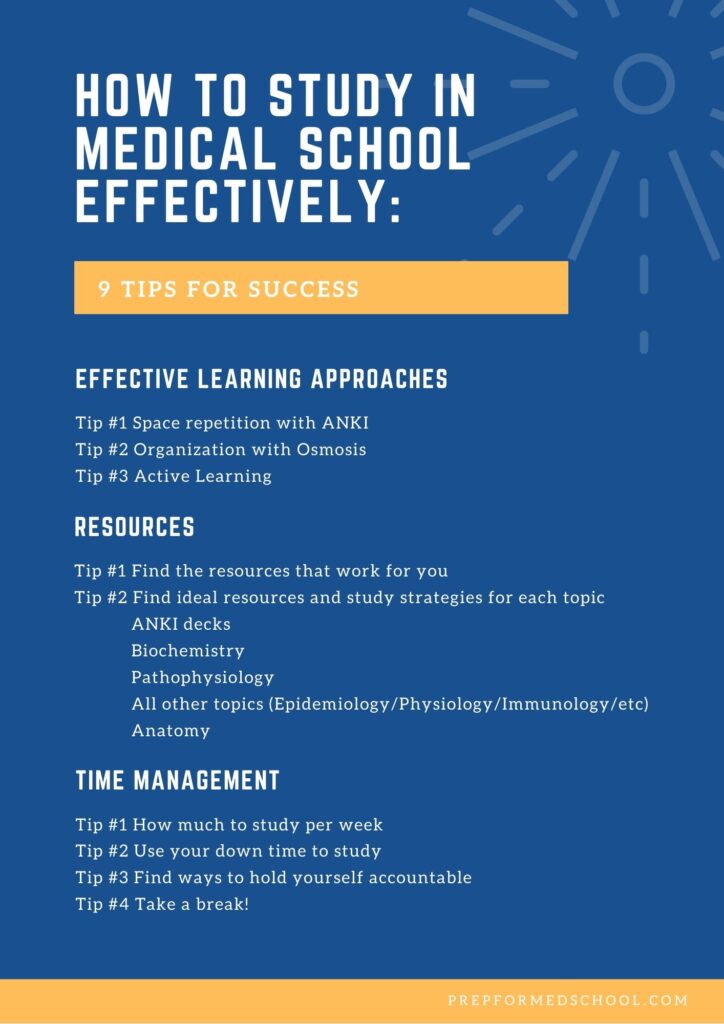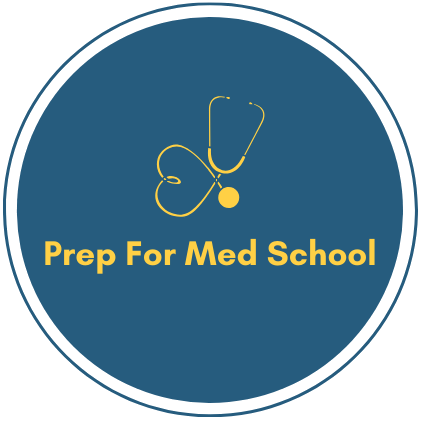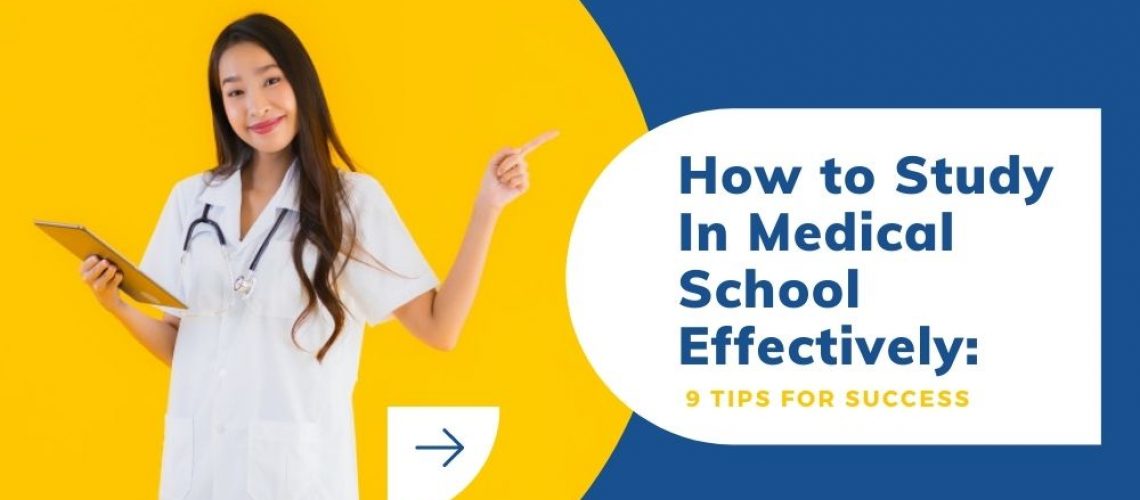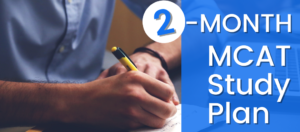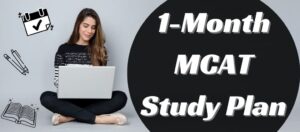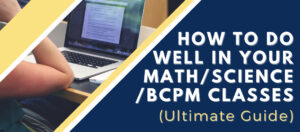If you are a current medical student or a pre-medical student hoping to matriculate into one, you have likely heard how intense medical school gets. I won’t lie to you. It is definitely true that the first two years of medical school are some of the most challenging years of my life. Between the endless lectures and an infinite amount of information to memorize, it can quickly get overwhelming. Many students find that the study methods that may have worked in undergraduate are no longer effective. Cramming the night before an exam no longer works when each lecture is the equivalent of several undergraduate lectures.
One popular analogy to describe life in medical school is that it is like “drinking from a firehose”. Another one that I heard from a medical school dean at a school I interviewed at is that it’s like eating multiple pancakes a day. You will have days where you don’t feel like eating, but that just means you have even more to eat the next day.
For me personally, adjusting to the medical school curriculum was definitely a challenge. In this article, I will provide some tips to adjusting to life in medical school.
Effective Learning Approaches
I will start off by talking about three key concepts required for success in medical school and how I incorporated them into my learning process.
Tip #1 Space repetition with ANKI
I was introduced to ANKI in the first few weeks of medical school by a friend. It ended up being one of the most helpful resources I used during my preclinical years. ANKI is an app that allows you to create and use virtual flashcards.
Cards can be designed in a variety of formats. For example, you can create cards in a more traditional format where you write a question in the front and the answer on the back. You can also design them to be fill in the blank (termed “cloze” style) so that only certain words are hidden. By installing a plugin. you can choose to occlude images as well, which is helpful in identifying and memorizing structures for anatomy.
ANKI is based on the idea of spaced repetition, a powerful learning technique that spaces out content review to improve long-term retention. Basically the idea is to learn something, see it again relatively soon, and then review it at intervals timed so that you see the material just before your knowledge of the topic begins to fade. This allows you to strengthen it at its supposed weakest link. Think of it a as a mental workout where instead of increasing the weight, you increase the interval between your exposure to the material.
ANKI utilizes a performance-based algorithm to program its intervals. For example, if you fail a card, it will show up in your queue until you are able to answer it. Since you failed initially, you must repeat it on the next day. As you become more successful at answering the card, it will come up again after a few days, then a few weeks, and eventually after a few months. If you forget it, you start the cycle over.
What makes ANKI so useful is its portability and user support. It is very easy to share decks and collaborate with others. There is even a large online reddit community that shares premade decks based on some of the most popular medical school resources. In addition, users are consistently creating new plugins that you can install on the app. My favorites are the calendar heatmap, which allows you to track how many days you’ve used ANKI in a row (this is super helpful to motivate you stay on track!), and the previously mentioned image occlusion plug in.
When you sign up for an ANKI account, it will synchronize your deck to Ankiweb. You can use the app on your phone, meaning you can work on cards easily while traveling or even in between your sets at the gym.
The way I used ANKI initially was to coordinate with a friend to make cards as we worked through lecture. We identified core concepts that we believed were testable and wrote cards designed to address these specific concepts. I used a mix of concept recall cards (“List 3 facts about topic X) and easier “cloze deletion” cards (“The macula is spared during posterior cerebral artery infarct is in collateral circulation with ____ artery”). Doing both helps balance difficulty with pacing so that I don’t end up taking too long to get through the deck.
I made lecture-based cards throughout year ! but stopped in year 2 as I focused more on STEP 1 preparation. Instead of making my own cards, I heavily used premade STEP 1 decks such as Zanki and lolnotacop, which can be found on the reddit. These were some of the gold standard decks when I was in my second year of medical school. Currently the gold standard deck for STEP 1 is the AnKing deck.
The most important thing about ANKI is consistency. You absolutely MUST do your cards when they are scheduled. If you have to take a day or two off, that’s fine but you must catch up to get back on schedule. Since the whole concept is based on spaced repetition, you need to stick to the schedule to optimize the benefit of ANKI.
Tip #2 Organization with Osmosis
Staying organized is an important skill as a medical student. Between lectures, notes, and flashcards, there is a lot to keep of. It’s something I had trouble with early on. At least until I found out about Osmosis.
I first heard about Osmosis halfway through my first year of school and once I tried it out, I knew it was exactly what I needed. You can think of Osmosis as the center point for your medical school learning. It’s an online platform where you can upload lectures, create flashcards, access learning videos, and work through questions. What is great is that you can set up groups with your entire class as well as your specific study group.
When you upload a lecture on Osmosis, it automatically scans the lecture, looking for keywords. It then automatically tags slides with helpful videos and notes. When you work through the lecture, you can then easily access the Osmosis videos (which are absolutely fantastic for learning a topics) and premade cards that relate to a topic. It also comes with questions that cover the topic at hand.
What made Osmosis so useful is helps keep you organized. Instead of digging through my computer, having separate files/platforms for my lectures and notes, I now had everything in one system.
The collaborative feature was super helpful. Instead of sending ANKI decks to each other, my study group and I coordinated cards on Osmosis. Since the cards synchronize automatically when they are updated, it made it much easier to correct cards and stay up to date. As I started moving away from lectures in year 2, I stopped making cards entirely and started using ones made by other classmates who were more focused on lecture. This saved me a lot of time.
Tip #3 Active Learning
With the enormous amount of information you are expected to memorize in medical school, it can be hard enough to just pass through all the information once. It’s easy to resign yourself to the idea that you have to spend as much time as possible, studying every factoid presented to you.
However, every successful student comes to realize that it is not about just seeing the information, but about being able to thoroughly understand and apply that information. Essentially, this means that as a medical student, you will need to find a method of active learning.
The methods I found to be the most effective were:
1) Studying with friends. After learning on our own, we went through concepts and explained it to each other. It was always great when one of us had questions, because it forced someone else to explain concepts. Often this discussion would highlight gaps in our understanding that we were not aware of earlier
2) Going through test banks like Uworld and Kaplan. These passage-based questions were often more intense then the lecture questions, but were useful in learning how to integrate and apply knowledge.
Resources
Tip #1 Find the resources that work for you
Most medical students have heard of the popular UFAP resources (Uworld, First aid, Pathoma, Sketchy). These were primarily optimized for STEP learning. A more in-depth discussion of these resources can be found elsewhere, but I’ll give a quick overview here.
Pathoma is an excellent breakdown of pathophysiological concepts explained by Dr. Sattar, who makes these concepts easily digestible. Sketchy uses picture mnemonics to help you memorize facts in pharmacology, microbiology, and pathology. First aid is an outline of the things you need to know for STEP 1. Finally, Uworld is a challenging test bank that is the gold standard for STEP 1 preparation.
While I personally found them to be great resources that supplemented (or even replaced) my lectures, it’s important to realize that these resources don’t work for everyone. I have friends who preferred Boards and Beyond to Pathoma. While I really benefitted from Sketchy Pharmacology and Pathology, others found them to be way too dense to be any of use.
My advice is find the resources that work for you early on and have a system to integrate them with your lecture material. For example, I would watch Pathoma and Sketchy first to understand the lecture material, then watch the corresponding lecture material to fill in the blanks for what I needed to know for you exams.
Tip #2 Find ideal resources and study strategies for each topic
Medical school lectures be a mixed breed. You will have some fantastic lectures given by professors dedicated to teaching, some lectures that seem like they were put together the night before, and everything in between. Fortunately, the resources your school provides are not the only way to learn the material for medical school.
It’s also important to realize that you might need to change your approach for each topic. In this section, I will discuss the course-specific resources that I found to be helpful. I’ll also mention if there were any additional studying approaches that I found helpful for each topic.
Microbiology/Pharmacology – I grouped these two together because for both, I almost exclusively learned from Sketchy and the associated ANKI decks. I would typically watch the sketchy videos, complete the associate cards, then watch lectures, and take a note of anything that was not covered in Sketchy.
ANKI decks
Microbiology – lolnotacop or pepper micro (I prefer lolnotacop)
Pharmacology – Zanki Pharmacology
Biochemistry
Typically, I would not recommend using a textbook in medical school. However, biochemistry is the exception. Lehninger Principles of Biochemistry is an excellent, straightforward text that does a fantastic job of explaining biochemistry concepts.
If you’re not a fan of textbooks, the Boards and Beyond Biochem lectures are a good substitute.
Another helpful resource is Pixorize . This is similar to the more popular Sketchy but covers different topics. The biochem videos were great for memorizing things, especially genetic disorders.
Other helpful strategies: Drawing! I would draw out pathways and reactions, which really helped me memorize each step.
Pathophysiology
I would use Pathoma to learn the main concept, followed immediately by Sketchy Pathology to memorize all the facts. I would immediately run through the relevant Zanki cards to solidify my knowledge of the material.
All other topics (Epidemiology/Physiology/Immunology/etc)
Boards and Beyond is great as a comprehensive resource. Dr. Ryan does a fantastic job of explaining concepts. A great supplement are the Osmosis videos, as they really help you see exactly what Dr. Ryan is talking about!
Anatomy
The best way to learn anatomy is to work with a partner at lab. Usually, my partner and I would go back and forth to quiz each other on structures in the cadaver.
As far as virtual resources, the top two in my opinion are Biodigital and the University of British Columbia (UBC) Neuroanatomy webpage. Biodigital renders a 3D virtual human body. You can select specific structures so that you can focus on a specific subset that you are interested in.
If you would like to use ANKI for anatomy, definitely download the image occlusion plugin so that you can put images in your ANKI deck.
Time Management
Tip #1 How much to study per week
This varies from person to person, depending on what your learning preferences are, whether you attend classes in person, and how much time you are required to be in school per week. Generally speaking, it Is best to treat medical school like a full-time job and study between 40-50 hours a week, between 6-8 hours a day.
At my school, we had two hours of lecture and two hours of small group activities per day. I preferred to watch lectures at home and spent 2-3 hours per lecture, depending on the content and how detailed my lectures notes were.
As time went on, my friends and I figured out a system where we split note/flashcard assignments. It would end up taking me 3-4 hours to finish a day’s worth of lectures in this new system, as I only spent 3 hours on the lecture I was assigned to and could finish the other in an hour. The rest of the time, I would spend on ANKI and question banks.
This would change during exam week. I think I would bump my studying up to 10-12 hours a day as I went through all the lecture material again and tested concepts with friends.
Tip #2 Use your down time to study
One of the best ways to study is to take the down time from other aspects of your life and use those to study. For example, while traveling, I often found myself with nothing to do while in a bus or airplane. I made sure to use this time effectively to study.
Another example is that as STEP 1 got closer, I started using my rest sets at the gym to run through a couple flashcards. It’s not much on its own, but in the long run, this adds up and significantly reduces the card load for the day.
Tip #3 Find ways to hold yourself accountable
I personally am a big procrastinator. One way I was able to partially overcome this is by putting myself in situations where I was held accountable. For example, by forming study collaborations, I was responsible for the creation of lecture-specific note and flashcards. This forced me to complete lectures every day so that I would not let my friends down. I knew that if I only did it for myself, it would never work
Tip #4 Take a break!
With any study plan, it is just as important to build in time off and take breaks. Learning how to balance academic commitments with your personal life is a crucial skill to develop as a medical student.
I often found that if I I dedicate an entire day to studying without planning any breaks, my day would often be inefficient. Without programming those breaks beforehand, I would burnout and eventually get distracted by looking at my phone or going on a social media site. However, if you plan those breaks in your schedule, then it can help you keep focused in the long run while still letting you do all the things that wanted to do.
Another way to program breaks is through the pomodoro technique. This technique involves on/off phases where you study for 25-30 minutes straight then force yourself to take a 5 minute break.
However, it’s not just about taking a few hours off. This advice also applies in the long run. Medical school is a marathon. You need to program in entire days to take off. For me, I enjoyed traveling and I forced myself to find the time to travel, go on hikes, etc.
Other examples include, pursuing a hobby or attending social events. What it is, it needs to take your mind off medical school for a little bit. You’ll find that when you come back, you’ll be returning with clarity and feeling reenergized.
Conclusion
One of the most difficult things to do as a medical student is figuring out an effective study routine. This article described just a few things that worked for me but honestly the process will be different for everyone. The important thing is to realize that it’s a challenge for everyone, not just you. Many people do poorly on their first few exams but eventually figure out a study strategy that works out for them. If you find yourself struggling to study in medical school, realize that is a normal process of the medical school orientation process. It’s not a matter of whether you belong or not, but instead it is an issue of finding the best study habits and plans that work for you.
